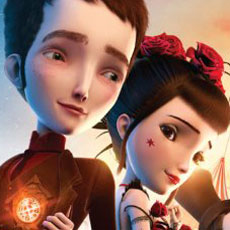Studio Ghibli (July 15, 1995), Walt Disney Home Entertainment (March 7, 2006), 2 discs, 111 mins plus supplements, 1.85:1 anamorphic widescreen, Dolby Digital 5.1, Rated G, Retail: $29.99
Storyboard:
A fourteen-year old girl struggles with family expectations as she searches for her true path.
The Sweatbox Review:
Of the three Studio Ghibli films released in March 2006, the lowest profile one was undoubtedly Whisper Of The Heart. While Howl’s Moving Castle was nominated for an Oscar, and My Neighbor Totoro had a previous successful home video release from Fox and is an acknowledged classic family film besides, Whisper is a relative unknown even to the average anime fan. And that is why I chose to review it. I have no doubt that I will love the others when I watch them, but I was most looking forward to what I might discover inside a film which I knew nothing about. Ah, the fun of doing DVD reviews!
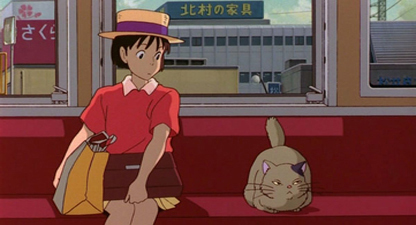
Most of the Ghibli films have been directed by the master, Hayao Miyazaki; but for this one he stuck to doing the screenplay and storyboards, as well as his usual producer responsibilities. The director here is Yoshifumi Kondo (except for a fantasy scene with flying, which Miyazaki handled). Kondo had been an associate of Miyazaki for many years, and previously served as animation supervisor on several Ghibli films. It was anticipated that he would be directing more films as Miyazaki planned his retirement, but unfortunately Kondo passed away in 1998 at the age of 47. It truly is a shame, because he handled his one film beautifully. Animation buffs may also wish to note that this was the first Ghibli film to use computer technology, albeit just digital compositing in this case. Everything in the film was animated traditionally, but the flying scene with Baron had its elements combined using a computer.
Whisper Of The Heart, like many anime films, began as a manga; this one’s title actually translates to “If You Listen Closely”. This was a different type of choice for Ghibli to make, as Whisper is much more of a “girls’ drama”, rather than the fantasies or ecological fables that the studio is most known for. Miyazaki was apparently drawn towards its themes of non-conformity and following your dreams, and his work on the screenplay is a revelation for its sensitivity and naturalism. Watching the film, I was struck by just how real the story seemed to feel, as if I was back in junior high myself, and watching my friends go through what teenagers go through.
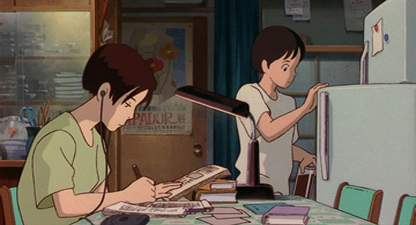
But in truth, this is a story that takes place in Tokyo, not North America. The main character is Shizuku Tsukishima, a fourteen-year old girl who is struggling just a bit with the expectations of her family and society. She is supposed to be preparing for the exams that will determine her high school placement (and by extension her whole future), but her focus is instead on reading books of fairy tales and the like. Her parents appreciate her free spiritedness, but naturally want her to be prepared for the real world, while her sister is much more blunt in her disapproval of Shizuku’s seemingly irresponsible behavior. It is obvious that Miyazaki the screenwriter himself sides with Shizuku, scolding the rigidity of Japanese society and its insistence on valuing people according to their academic records. Such an outlook, after all, does not foster the arts or self-expression.
That is not to say that this is an overly serious or heavy-handed film, however. The story largely focuses on the relationship that Shizuku develops with a boy from her school, a boy who has apparently taken out the same library books that she has, and whose path she feels she will inevitably cross. Aside from the book connection, she finds a further link with the boy when she visits an antique shop after following an odd cat across town, a cat that takes the train. Through various coincidences and events, she does meet the boy, Seiji Amasawa. At first their relationship seems antagonistic, but when they finally actually have a conversation, they develop an almost immediate and close friendship. They especially find rapport in their common outlooks. Both of them are dreamers, with Seiji planning a career as a violin maker and Shizuku filling her days with reading and writing. As much as Seiji admires Shizuku, it is Shizuku who finds inspiration in the boy, as she becomes determined to write a real story instead of just dabbling in writing silly song lyrics. Just as her attraction to boys is awakened, she realizes that it is time for her to grow up.

The story that Shizuku writes becomes based on the Baron, a cat statue owned by the antique shop owner. This is the same Baron that later appeared in Whisper Of The Heart’s quasi-prequel, The Cat Returns. (Her contemplation of Baron’s story leads to the film’s only fantasy sequences, much different in conception than the “real” story.) The antique shop owner is another important character, who teaches Shizuku how an artist must work hard and have patience to develop his or her craft. The kindness of the old man gives her great comfort, given that (like all teenagers) she is having difficulty believing in herself or even knowing in what direction she wants to take her life.
More teenage angst is featured in a parallel storyline involving a “like” triangle with Shizuku and two more of her friends. We also see Shizuku at home with her parents and older sister, where it is clear that Shizuku feels restrained by the circumstances of family living and the expectations of her parents and sibling. All these difficulties— romantic, familial, and general growing up— reminded me very much of my own teenage experiences, and struck me as being particularly real. Fortunately, the story never seems to dissolve into soap opera or melodrama, although it does teeter on the brink at times.
In the end, Shizuku and Seiji both find direction, and even though a happy ending for the two of them together is suggested, one gets the feeling that they would do just fine apart, strengthened by what they have gained from each other.
This is a sweet story that transcends cultural divides. Although the setting is very Japanese, and the cultural influences on the story are central to some of the themes, the truth of a young person’s existence during the transition to adulthood is universal. Aside from the “teenager” angle, there are several other scenes that simply show true-to-life occurrences and are just blissful. A key example is the impromptu singing of Country Road with Shizuku and the antique shop owner and his friends, with Seiji playing violin; this scene epitomizes the joys to be found in unexpected events in real life.
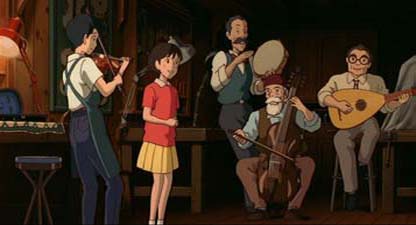
This is perhaps Ghibli’s most urban film. The sounds of the city are always noticeable, and the backgrounds are painted almost to be photorealistic at times. Buildings are given a large amount of detail and are even allowed to look dirty or old. Power poles dot the picture, garbage cans are visible, and the city looks very busy. This is the real world, no doubt about it. I also noticed that the color pallet is deeper here than in most Ghibli films, which I often find to look a little washed-out. I found it ironic, then, that they made a choice to go with more vibrant colors for a drama, and more subdued colors for their fantasies— just the opposite of what one might expect. It works wonderfully, though; Shizuku’s world is solid and real, contrasted with the fairy tales she loves to immerse herself in.
There is so much truth in this movie that it is really beautiful at times. I quite enjoyed it, and know that my wife will love it when she gets a chance to watch it. It’s a different type of animated film, one that feels more like an “indie” film than a major studio release. As such, it holds a special place in the Ghibli filmography, and is a lasting tribute to its late director.
Is This Thing Loaded?
This release is quite similar to other Ghibli films that Disney has released, carrying the usual bonus features. Behind The Microphone (8:00) shows off the English voice cast, and is typical of what one would expect. The first disc also has Trailer And TV Spots (10:45)— enough that they do get quite repetitive after the first few. I found it interesting that the trailers acknowledged that the production of this film was inspired by the recent sales success of comic books aimed at girls.
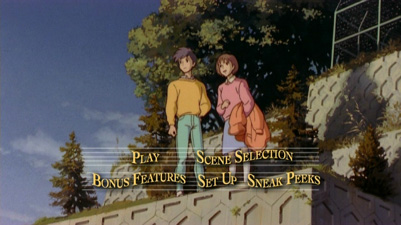
The second disc is devoted to Complete Storyboards for the film, a staple of these Ghibli releases and a real treat for fans of the animated form. You may view the storyboards with either the Japanese or English soundtrack, with the option of English subtitles.
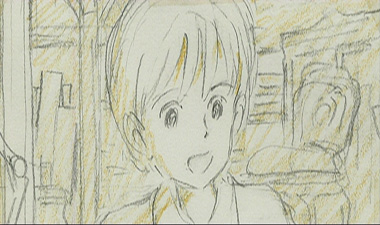
In case you are interested, the Previews on this disc include a general one for Studio Ghibli films, and separate ones for The Little Mermaid, Cars, Chicken Little, Chronicles Of Narnia: The Lion, The Witch, And The Wardrobe, and AirBuddies.
One extra that Disney missed out on is On Your Mark, an animated short that originally was shown with Whispers Of The Heart in Japanese theaters. It would have been nice to see it appear on this disc too, but for now it will simply have to be seen as a missed opportunity.
Case Study:
Keepcase with tray and an identical slipcover.
Ink And Paint:
The 1.85:1 anamorphic image is very nearly perfect. I noticed only a very rare instance of shimmering, but otherwise this is reference quality. The lack of halos or pixellation allows the transfer to look superb, in conjunction with a very clean print. All the detail in the backgrounds pops out nicely. It was nice to see one of Ghibli’s most colorful films treated so well.
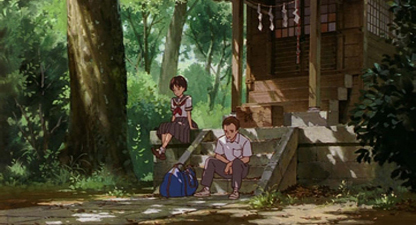
Scratch Tracks:
This was reportedly just about the first Japanese film to use the Dolby Digital sound system, and it is shown off very well in the DVD release. Right from the opening, with a stellar rendition of Take Me Home, Country Road, the viewer is given notice that this soundtrack is going to be full and rich. Even as the music eventually fades, the speakers instead become full with the sounds of the city. Whether strolling down a road, riding a bus, or sitting in a park, the characters are immersed in a true cityscape of sound. Best of all, you have the choice to listen in full 5.1 sound with either the original Japanese track or a newly produced English dub. Of the English voice actors, one of the better known would be Cary Elwes, who also took the role of Baron for the dub of The Cat Returns.
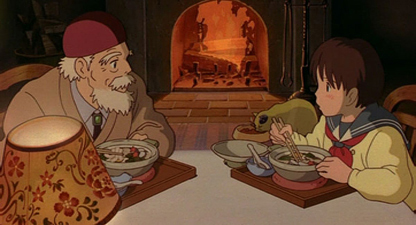
There are three English subtitle streams: Subtitles, captions for the hearing impaired, and a default one that translates Japanese on-screen text.
Final Cut:
I love what Disney has been doing for these Ghibli releases. True, the extras are a bit sparse beyond the disc devoted to storyboards (okay, that is pretty cool by itself), but what is most wonderful is that these Japanese films can find a whole new audience. Whisper Of The Heart is simply a tender, heartfelt film that can be enjoyed by many types and ages of viewers. The mid-section dragged slightly for me, but otherwise I found this film to be very enjoyable and full of truth about growing up. For a film so steeped in real life, it has a special magic about it, reminding us that real life can be magical when you let it. The company of friends, meeting someone new… those moments can be magical. Recommended for the whole family, even dads who normally prefer robots and spaceships in their anime.
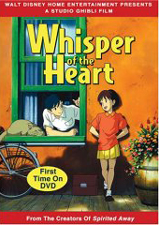 | ||
 |






